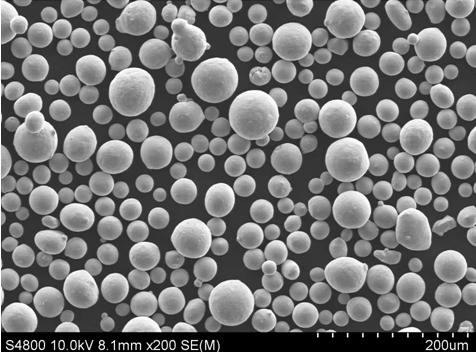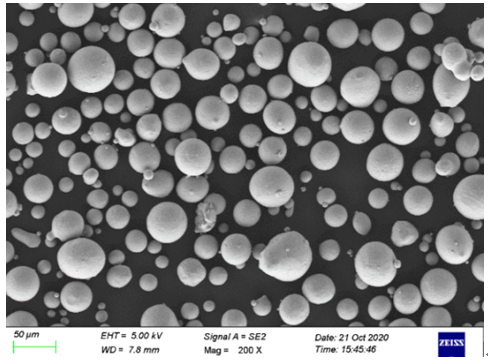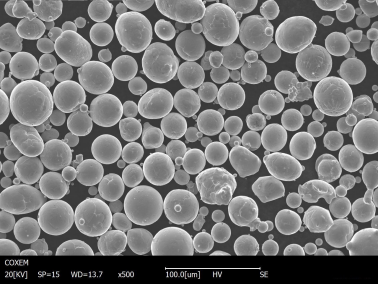Fusion par induction par électrodes Atomisation par gaz inerte (EIGA) est un processus fascinant et hautement technique utilisé dans la production de poudres métalliques de haute qualité. Cette technique est particulièrement appréciée pour sa capacité à produire des poudres d'une excellente pureté, avec une distribution granulométrique uniforme et des morphologies de particules spécifiques, qui sont essentielles dans diverses applications de fabrication de pointe. Dans ce guide complet, nous allons nous plonger dans les subtilités de l'EIGA, explorer des modèles de poudres métalliques spécifiques et donner un aperçu détaillé de ses propriétés, de ses applications et de ses avantages.
Aperçu de la fusion par induction d'électrodes Atomisation par gaz inerte
L'atomisation par gaz inerte est un processus qui implique la fusion d'une électrode métallique par induction, suivie de l'atomisation du métal fondu en fines particules à l'aide d'un gaz inerte. Cette méthode est très appréciée pour produire des poudres exemptes de contamination, ce qui est crucial dans des applications telles que la fabrication additive, la métallurgie des poudres et les céramiques avancées.
Caractéristiques principales de l'EIGA :
- La pureté : Le processus minimise la contamination, ce qui garantit des poudres métalliques d'une grande pureté.
- Contrôle de la taille des particules : Permet un contrôle précis de la distribution de la taille des particules.
- Particules sphériques : Produit des particules sphériques, améliorant la fluidité et la densité de tassement.
- Polyvalence : Peut être utilisé avec une large gamme de métaux et d'alliages.

Composition et propriétés des poudres EIGA
Il est essentiel de comprendre la composition et les propriétés des poudres EIGA pour sélectionner le matériau adéquat pour des applications spécifiques. Ci-dessous, nous explorons les compositions et les propriétés de diverses poudres métalliques produites à l'aide de l'EIGA.
Types et compositions des poudres EIGA :
| Poudre métallique | Composition | Propriétés |
|---|---|---|
| Titane (Ti-6Al-4V) | 90% Titane, 6% Aluminium, 4% Vanadium | Haute résistance, légèreté, résistance à la corrosion |
| Alliage de nickel (Inconel 718) | 50-55% Nickel, 17-21% Chrome, 4,75-5,5% Niobium, plus Fer, Molybdène, Titane | Résistance aux températures élevées, résistance à la corrosion |
| Acier inoxydable (316L) | 16-18% de chrome, 10-14% de nickel, 2-3% de molybdène, équilibre du fer | Résistant à la corrosion, bonnes propriétés mécaniques |
| Alliage de cobalt-chrome (CoCrMo) | 60-65% Cobalt, 26-30% Chrome, 5-7% Molybdène | Haute résistance à l'usure, biocompatible |
| Alliage d'aluminium (AlSi10Mg) | 85-90% Aluminium, 9-11% Silicium, 0,2-0,4% Magnésium | Léger, bonnes propriétés mécaniques, coulable |
| Cuivre (Cu) | 99% de cuivre | Excellente conductivité électrique et thermique |
| Tungstène (W) | tungstène à 99 | Très haute densité, point de fusion élevé |
| Alliage de magnésium (AZ91D) | 90-93% de magnésium, 8-9% d'aluminium, 0,2-1% de zinc | Léger, bonne coulabilité |
| Acier à outils (H13) | 0.32-0,45% Carbone, 4,75-5,5% Chrome, 1,1-1,75% Molybdène, équilibre Fer | Haute résistance à l'usure, bonne ténacité |
| Aluminure de titane (TiAl) | 45-48% Titane, 48-51% Aluminium | Léger, résistant aux températures élevées |
Caractéristiques des poudres EIGA :
| Caractéristique | Description |
|---|---|
| Morphologie des particules | Sphérique, améliorant la fluidité et la densité de tassement |
| La pureté | Élevé, grâce à l'atmosphère de gaz inerte qui empêche l'oxydation et la contamination |
| Distribution de la taille des particules | Étroite et contrôlable, essentielle pour les processus de fabrication précis |
| Densité | Densités de piquage et de masse élevées, avantageuses pour les techniques de fusion sur lit de poudre |
| Surface | Contrôlé pour optimiser les processus de frittage et de fusion |
Applications des poudres EIGA
Les poudres EIGA trouvent des applications dans diverses industries, chacune tirant parti des propriétés uniques de ces poudres métalliques de haute qualité. Vous trouverez ci-dessous un tableau détaillé des différentes applications.
Applications et utilisations des poudres EIGA :
| L'industrie | application | Avantages |
|---|---|---|
| Aérospatiale | Aubes de turbines, composants structurels | Rapport résistance/poids élevé, résistance à la température |
| Médical | Implants, prothèses, applications dentaires | Biocompatibilité, résistance à la corrosion |
| Automobile | Composants du moteur, échangeurs de chaleur | Léger et performant |
| Électronique | Encres conductrices, dissipateurs thermiques | Excellente conductivité électrique |
| L'énergie | Piles à combustible, composants de batteries | Efficacité et fiabilité élevées |
| Fabrication additive | impression 3D de géométries complexes | Flexibilité de la conception, réduction des déchets de matériaux |
| Métallurgie des poudres | Pièces frittées, roulements | Haute densité, microstructure uniforme |
| Revêtements | Revêtements par projection thermique, revêtements résistants à l'usure | Propriétés de surface améliorées, durabilité |






Spécifications, tailles, qualités et normes
Lors de la sélection des poudres EIGA pour des applications spécifiques, il est essentiel de comprendre les spécifications, les tailles, les qualités et les normes associées à ces matériaux.
Spécifications et normes pour les poudres EIGA :
| Poudre métallique | Gamme de taille des particules (µm) | Classes normales | Normes pertinentes |
|---|---|---|---|
| ti-6al-4v | 15-45, 45-90 | 5e année | ASTM F2924 |
| Inconel 718 | 15-45, 45-106 | AMS 5662 | AMS 5662, ASTM B637 |
| Acier inoxydable 316L | 15-45, 45-106 | ASTM F138 | ASTM A276, F138 |
| CoCrMo | 15-45, 45-106 | ASTM F75 | ASTM F75 |
| AlSi10Mg | 15-45, 45-106 | EN AC-43400 | EN 1706 |
| Cuivre | 15-45, 45-106 | OFHC | ASTM B216 |
| Tungstène | 15-45, 45-106 | W1, W2 | ASTM B777 |
| AZ91D Magnésium | 15-45, 45-106 | ASTM B93/B93M | ASTM B93/B93M |
| Acier à outils H13 | 15-45, 45-106 | ASTM A681 | ASTM A681 |
| Aluminure de titane | 15-45, 45-106 | Sur mesure | ISO 5832-3 |
Fournisseurs et détails des prix
Pour obtenir des poudres EIGA de haute qualité, il est essentiel d'identifier des fournisseurs réputés et de comprendre les détails des prix. Vous trouverez ci-dessous un tableau présentant quelques fournisseurs clés et des prix indicatifs.
Fournisseurs et prix des poudres EIGA :
| Fournisseur | Poudre métallique | Fourchette de prix (USD/kg) | Informations sur le contact |
|---|---|---|---|
| Praxair Surface Technologies | ti-6al-4v | $200 – $300 | Site web de Praxair |
| Additif pour charpentier | Inconel 718 | $150 – $250 | Site web de Carpenter Additive |
| GKN Hoeganaes | Acier inoxydable 316L | $100 – $200 | Site web de GKN Hoeganaes |
| HC Starck Solutions | CoCrMo | $200 – $300 | Site web de HC Starck Solutions |
| ECKART Amérique | AlSi10Mg | $50 – $100 | Site web d'ECKART |
| AMETEK Produits métalliques spécialisés | Cuivre | $50 – $100 | Site web d'AMETEK SMP |
| Advanced Powder & ; Coatings Ltd. | Tungstène | $300 – $500 | Site web d'Advanced Powder & ; Coatings |
| Zhongnuo Advanced Material | AZ91D Magnésium | $50 – $100 | Site web de Zhongnuo |
| Kennametal | Acier à outils H13 | $100 – $200 | Site web de Kennametal |
| ATI Metals | Aluminure de titane | $300 – $500 | Site web d'ATI Metals |
Comparaison des avantages et des inconvénients des poudres EIGA
L'évaluation des avantages et des limites des poudres EIGA permet de prendre des décisions éclairées pour des applications spécifiques.
Avantages et limites des poudres EIGA :
| Avantage | Description |
|---|---|
| Haute pureté | L'EIGA minimise la contamination et produit des poudres d'une grande pureté. |
| Taille uniforme des particules | Permet un contrôle précis de la distribution de la taille des particules. |
| Particules sphériques | Améliore la fluidité et la densité d'emballage, cruciales pour la fabrication additive. |
| Gamme de matériaux polyvalents | Peut produire des poudres à partir d'une large gamme de métaux et d'alliages. |
| Faible teneur en oxygène | L'atmosphère de gaz inerte réduit l'oxydation et préserve l'intégrité des matériaux. |
| Limitation | Description |
|---|---|
| Coût | Les poudres EIGA peuvent être plus chères que d'autres méthodes. |
| Complexité | Le processus nécessite un équipement et une expertise sophistiqués. |
| Production volume | Peut être limité dans le volume de poudre qui peut être produit en un seul lot. |
| Consommation d'énergie | Besoins énergétiques élevés en raison de la fusion par induction. |
Aperçu et exemples détaillés
Titane (Ti-6Al-4V) contre Inconel 718 :
Le titane Ti-6Al-4V et l'Inconel 718 sont deux poudres métalliques de premier plan utilisées dans des applications de haute performance. Le Ti-6Al-4V, connu pour son rapport poids/résistance élevé et sa résistance à la corrosion, est largement utilisé dans les domaines aérospatial et biomédical. En revanche, l'Inconel 718, avec sa résistance supérieure à haute température et à l'oxydation, est préféré pour les composants aérospatiaux qui fonctionnent dans des environnements extrêmes. Si l'on compare les deux, le Ti-6Al-4V est plus léger et convient mieux aux applications sensibles au poids, tandis que l'Inconel 718 offre de meilleures performances dans des conditions de haute température.
Acier inoxydable 316L contre alliage d'aluminium (AlSi10Mg) :
L'acier inoxydable 316L et l'alliage d'aluminium AlSi10Mg sont couramment utilisés dans la fabrication additive. l'acier inoxydable 316L est apprécié pour sa résistance à la corrosion et ses propriétés mécaniques, ce qui le rend idéal pour les applications médicales et marines. D'autre part, l'AlSi10Mg, léger et coulable, est excellent pour les applications automobiles et aérospatiales où la réduction du poids est cruciale. Le choix entre ces matériaux se résume souvent aux exigences spécifiques de l'application, le 316L offrant la durabilité et l'AlSi10Mg les économies de poids.
Alliage de cobalt-chrome (CoCrMo) pour applications médicales :
L'alliage cobalt-chrome (CoCrMo) est largement utilisé dans les applications médicales, en particulier dans les implants et les prothèses, en raison de sa grande résistance à l'usure et de sa biocompatibilité. La capacité de l'alliage à résister à l'environnement hostile du corps sans se dégrader en fait un choix de premier ordre pour les implants à long terme. En outre, ses propriétés mécaniques sont bien adaptées aux applications de support de charge, ce qui garantit la fiabilité et la longévité des dispositifs médicaux.

FAQ
| Question | Réponse |
|---|---|
| Qu'est-ce que la fusion par induction par électrodes et l'atomisation sous gaz inerte ? | L'EIGA est un procédé qui consiste à faire fondre une électrode métallique par induction et à atomiser le métal fondu en fines particules à l'aide d'un gaz inerte. |
| Quels sont les métaux qui peuvent être traités par l'EIGA ? | Une large gamme de métaux et d'alliages, notamment le titane, le nickel, l'acier inoxydable, le cobalt-chrome, l'aluminium, le cuivre, le tungstène, le magnésium, l'acier à outils et l'aluminure de titane. |
| Quels sont les avantages de l'utilisation des poudres EIGA ? | Les poudres EIGA offrent une grande pureté, une taille de particule uniforme, une morphologie sphérique et une faible teneur en oxygène, ce qui les rend idéales pour les applications de fabrication de pointe. |
| Comment l'EIGA se compare-t-il aux autres méthodes de production de poudres ? | L'EIGA offre une pureté et un contrôle des particules supérieurs à ceux des méthodes telles que l'atomisation au gaz ou à l'eau, bien qu'elle puisse être plus coûteuse et plus complexe. |
| Quelles sont les applications courantes des poudres EIGA ? | Les applications comprennent les composants aérospatiaux, les implants médicaux, les pièces automobiles, l'électronique, les systèmes énergétiques, la fabrication additive, la métallurgie des poudres et les revêtements. |
| Quels sont les facteurs à prendre en compte lors de la sélection des poudres EIGA ? | Les facteurs clés sont les exigences spécifiques de l'application, les propriétés souhaitées du matériau, la distribution de la taille des particules, la pureté et le coût. |
| Les poudres EIGA peuvent-elles être utilisées dans la fabrication additive ? | Oui, les poudres EIGA conviennent parfaitement à la fabrication additive en raison de leur distribution granulométrique contrôlée et de leur grande pureté, qui améliorent la qualité des pièces imprimées. |
| Quelle est la granulométrie typique des poudres EIGA ? | La taille des particules varie généralement de 15 à 106 microns, en fonction de l'application et des besoins. |
| Y a-t-il des limites à l'utilisation des poudres EIGA ? | Les limites sont notamment les coûts plus élevés, la complexité du processus, les volumes de production limités et la consommation d'énergie élevée. |
| Où puis-je acheter les poudres EIGA ? | Parmi les fournisseurs réputés figurent Praxair Surface Technologies, Carpenter Additive, GKN Hoeganaes, HC Starck Solutions, ECKART America, AMETEK Specialty Metal Products, Advanced Powder & ; Coatings Ltd, Zhongnuo Advanced Material, Kennametal et ATI Metals. |
Conclusion
Fusion par induction par électrodes Atomisation par gaz inerte est une technologie de pointe qui joue un rôle essentiel dans la production de poudres métalliques de haute qualité. Sa capacité à produire des poudres d'une pureté exceptionnelle, avec une distribution granulométrique précise et une morphologie sphérique la rend indispensable dans les secteurs de la fabrication de pointe tels que l'aérospatiale, la médecine et la fabrication additive. En comprenant la composition, les propriétés, les applications et les avantages des poudres EIGA, les industries peuvent tirer parti de cette technologie pour obtenir des performances supérieures et innover dans leurs produits.
Que vous soyez ingénieur, chercheur ou fabricant, ce guide complet fournit les connaissances et les idées nécessaires pour naviguer dans les complexités des poudres EIGA et prendre des décisions éclairées pour vos besoins spécifiques.

